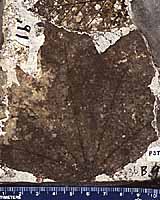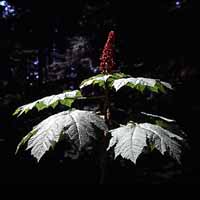







The Apiales first appear in the Maastrichtian (Cretaceous).
An examination of the fossil record requires extensive analysis of pollen morphology as viewed under a scanning electron microscope. Unfortunately, describing pollen accurately necessitates the use of a whole different vocabulary. Sometimes the utilization of more complex words becomes necessary in order to prevent confusion and repetition. Fossil pollen shows similar morphologies to modern pollen while some features show a clear lineage between ancient and current examples.
Existing pollen demonstrate similar morphology to fossil pollen. The Pleurosperum austriacum is a member of the Apiaceae that has similar proximal (facing towards the center) and distal (facing towards the outside) faces and a polar (north-south) axis longer than the equatorial (east-west) diameter. Other features include three apertures that reach the polar areas without fusing, a square shape, equatorial poles, and an outer layer that is laterally adjacent to the poles extending out of the sporoderm. Artedia squamata also belongs to the Apiaceae. Endemic to central Asia, its pollen appears triangular when viewed from above with a polar axis equal in length to the equatorial axis. Both of these pollen grains share a sculpture that resembles several short spikes in defined rows. Polar and equatorial projections are evident on both pollen types. These similar features show a resemblance between the two examples while the slightly different morphology differentiates these pollen grains. Comparing pollen requires the critical analysis of which features are important and which ones are not (Farabee, 1991).
The fossil pollen belongs to the group generally referred to as Triprojectates or Aquilapollenites. Specific pollen grains in these groups demonstrate similar characteristics to their modern counterparts. Aquilapollenites quadricretaceus pollen has poles of equal length much like Artedia squamata and has similar features on each side in a manner similar to P. austriacum (Farabee, 1991). Features consist of thickenings on the inner spore wall that become thickest at the equatorial projections, openings that are restricted to the tips of the equatorial projections, and a sculpture that is composed of small club-shaped structures that look like the ends of Q-tips, which is different from the mostly regular and fairly spiky sculpture of modern pollen (Hoen, 2000).
Ancient Pleurospermum pollen is fairly symmetrical with short equatorial projections just like their modern counterparts; however, the interwoven nerwork-like sculpture and long colpi (openings that have a length-to-width ratio greater than 2:1) distinguish it from modern Pleurosermum. This fossil was originally placed in another genus before being regrouped with the Triprojectates (Farabee, 1992). The general evolutionary trend of progressively shortening equatorial projections explains the current pollen grains that are without projections. The size of the spaces between successive layers of the sexine has also become progressively smaller, becoming small spikes as seen in the modern Pleurospermum. These similarities in pollen morphology show a clear lineage between primitive Triprojectates and modern Apiales (Farabee, 1991).
An exact fossil record would be impossible to recreate, but ones for Araliaceae and Apiaceae were available. An examination of the Pittospraceae may have proved more comprehensive, but the severe lack of research in this area has limited the scope of this paper. The Araliaceae originate from the Paleocene, with the oldest record being the Ticolporopollenites armatus, discovered in France and the upper tertiary of Europe. The Hedera of the Upper Miocene follows this group, with discoveries made in both Spain and northwestern Germany. Apiaceae has a much more extensive history. Starting with the Hydrocotyle and Bupleurum of the lower Eocene, the fossil record steadily progresses. The Sanicula have been found in the upper Eocene of England, including pollen deposits in Pliocene deposits in Portugal. Echinophora, found in the upper Eocene, have a characteristic dicolporate and equatorially constricted sculpture. Found in India, there are direct connections to Umbelliferoipollenites ovatus and Umbelliferoipollenites constrictus. The Pliocene era plant grouping Selinum is an oval group also taken from Portugal. Modern plants soon followed with similar morphologies (Muller, 1981).
 |
 |
Fossil Apiales : On the left, a fossil of Kalopanax acerifoilum from the Miocene of Shandong, China. On the right, the living species Oplopanax horridum from Mt. Rainier in Washington state, USA. Compare the large leaves of these two species (click on either picture for a larger image).
The Apiales as a group have a relatively short but rich fossil history. Records of all groups existed by the Eocene epoch. Several groups from the Araliaceae go back to the Paleocene (Farabee, 1993). The major ancestor is the group Triprojectates, which comes from this epoch. Pollen grains have evolved a fairly rounded shape with tiny equatorial projections. The lumen, or spaces in between the structures supporting the spore wall, has also grown smaller with time. Shapes have diverged slightly over time, with a few modern triangular examples. The curious absence of actual samples of plant fossils is odd. Neither leaf traces nor stems have been plentiful. This could be due to the tropical environment that most of these plants thrived in. The high turnover rate of soil in these environments and the wet conditions would not be conducive to fossilization of plant material. Also, the impending Ice Ages of the Pliocene would drastically alter the climate, causing a fundamental shift in the landscape that excluded most plants, Apiales included. Fossil remains may have become lost in the shifts in plate tectonics that occurred between the Eocene epoch and present day.

The image of Oplopanax is the property of the Jepson Herbarium.
Sources:

